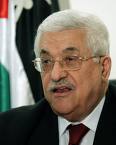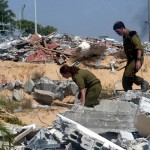Saturday
May302009
Damascus Matters: Syria, the US, and the New Middle East
 Saturday, May 30, 2009 at 12:50
Saturday, May 30, 2009 at 12:50
Video: Palestine Latest - Settlements and Blockades but No Reconstruction
After The Obama-Abbas Meeting: A Palestinian Stuck between Washington and Tel Aviv
Video and Full Transcript of Obama-Abbas Meeting (28 May)
 Much has changed in US foreign policy since the Bush Administration pulled its ambassador from Damascus in 2005 to protest Syria's suspected involvement in the assassination of the former Lebanese Prime Minister Rafik Hariri. Since the advent of the Obama Administration, not only the hopes of change in US-Syrian relations but the quest to unblock the Palestinian-Israeli peace process has brought the prospect of dialogue.
Much has changed in US foreign policy since the Bush Administration pulled its ambassador from Damascus in 2005 to protest Syria's suspected involvement in the assassination of the former Lebanese Prime Minister Rafik Hariri. Since the advent of the Obama Administration, not only the hopes of change in US-Syrian relations but the quest to unblock the Palestinian-Israeli peace process has brought the prospect of dialogue.
The latest signal came on Thursday when two Democratic Congressmen, Senator Edward E. Kaufman of Delaware and Representative Tim Waltz of Minnesota visited Syrian President Assad. According to Syria's official Arab News Agency, talks focused on "the necessity to remove obstacles that hinder relations and to promote stability in the Middle East". Specifically, the exchange points to a visit to Damascus by President Obama's envoy George Mitchell in June.
The Kaufman-Waltz visit is the fourth by US officials or legislators since January. Three days after the hard-line statement of the new Israeli Foreign Minister, Avigdor Lieberman, “Peace will only be in exchange for peace.”, Democratic Representative Stephen Lynch of Massachusetts and Republican Bob Inglis of South Carolina, met Assad.
Assad's comment after this meeting that he wanted to meet Obama personally was matched by the US Embassy's statement that the talks were constructive on Syrian-Lebanese relations, security on the Syria-Iraq border, and the situation in Gaza. On 5 May, two senior US officials, Jeffrey Feltman and Daniel Shapiro, made their second journey to Damascus in two months and found some “common ground” with the Syrians.
The 2nd Feltman-Shapiro visit was particularly significant as it came on the
same day that Assad and Iranian President Mahmoud Ahmadinejad met to re-confirm their ‘strategic alliance.’ Contrary to the claim of many that this was a declaration of Syria's "strategic needs" being met by Tehran; Assad's manoevure was more a temporary alignment with no advance on the "road map" of the Palestinian-Israeli and Syrian-Israeli peace processes. In the absence of tangible steps, Damascus is covering itself against any unilateral concessions.
Hence, the second visit of Feltman and Shapiro was needed to maintain close contact between Washington and Damascus until the peace process could be restarted. Other regional leaders have also contributed. On May 11, the Jordanian King Abdullah visited Damascus, as he and Assad affirmed the need for a comprehensive solution on the basis of Israeli and Palestinian states in a regional context. The newly-appointed Syrian ambassador to Ankara said on 12 May that Damascus was ready to resume Turkish-mediated indirect talks with Israel, despite Israeli Prime Minister Netanyahu’s statement that he would not cede the Golan Heights.
In contrast to the Bush Administration's attempt to get the "right" Middle East through exclusion of those whom it did not like or trust, the Obama Administration in four months has rebuilt relationships with key leaders. Still, the outcome of those initial breakthroughs awaits an even bigger signal: the US President's speech in Cairo next Thursday.
After The Obama-Abbas Meeting: A Palestinian Stuck between Washington and Tel Aviv
Video and Full Transcript of Obama-Abbas Meeting (28 May)
 Much has changed in US foreign policy since the Bush Administration pulled its ambassador from Damascus in 2005 to protest Syria's suspected involvement in the assassination of the former Lebanese Prime Minister Rafik Hariri. Since the advent of the Obama Administration, not only the hopes of change in US-Syrian relations but the quest to unblock the Palestinian-Israeli peace process has brought the prospect of dialogue.
Much has changed in US foreign policy since the Bush Administration pulled its ambassador from Damascus in 2005 to protest Syria's suspected involvement in the assassination of the former Lebanese Prime Minister Rafik Hariri. Since the advent of the Obama Administration, not only the hopes of change in US-Syrian relations but the quest to unblock the Palestinian-Israeli peace process has brought the prospect of dialogue.The latest signal came on Thursday when two Democratic Congressmen, Senator Edward E. Kaufman of Delaware and Representative Tim Waltz of Minnesota visited Syrian President Assad. According to Syria's official Arab News Agency, talks focused on "the necessity to remove obstacles that hinder relations and to promote stability in the Middle East". Specifically, the exchange points to a visit to Damascus by President Obama's envoy George Mitchell in June.
The Kaufman-Waltz visit is the fourth by US officials or legislators since January. Three days after the hard-line statement of the new Israeli Foreign Minister, Avigdor Lieberman, “Peace will only be in exchange for peace.”, Democratic Representative Stephen Lynch of Massachusetts and Republican Bob Inglis of South Carolina, met Assad.
Assad's comment after this meeting that he wanted to meet Obama personally was matched by the US Embassy's statement that the talks were constructive on Syrian-Lebanese relations, security on the Syria-Iraq border, and the situation in Gaza. On 5 May, two senior US officials, Jeffrey Feltman and Daniel Shapiro, made their second journey to Damascus in two months and found some “common ground” with the Syrians.
The 2nd Feltman-Shapiro visit was particularly significant as it came on the
same day that Assad and Iranian President Mahmoud Ahmadinejad met to re-confirm their ‘strategic alliance.’ Contrary to the claim of many that this was a declaration of Syria's "strategic needs" being met by Tehran; Assad's manoevure was more a temporary alignment with no advance on the "road map" of the Palestinian-Israeli and Syrian-Israeli peace processes. In the absence of tangible steps, Damascus is covering itself against any unilateral concessions.
Hence, the second visit of Feltman and Shapiro was needed to maintain close contact between Washington and Damascus until the peace process could be restarted. Other regional leaders have also contributed. On May 11, the Jordanian King Abdullah visited Damascus, as he and Assad affirmed the need for a comprehensive solution on the basis of Israeli and Palestinian states in a regional context. The newly-appointed Syrian ambassador to Ankara said on 12 May that Damascus was ready to resume Turkish-mediated indirect talks with Israel, despite Israeli Prime Minister Netanyahu’s statement that he would not cede the Golan Heights.
In contrast to the Bush Administration's attempt to get the "right" Middle East through exclusion of those whom it did not like or trust, the Obama Administration in four months has rebuilt relationships with key leaders. Still, the outcome of those initial breakthroughs awaits an even bigger signal: the US President's speech in Cairo next Thursday.
tagged  Add new tag,
Add new tag,  Arab News Agency,
Arab News Agency,  Assad,
Assad,  Avigdor Lieberman,
Avigdor Lieberman,  Benjamin Netanyahu,
Benjamin Netanyahu,  Bob Inglis,
Bob Inglis,  Bush Administration,
Bush Administration,  Cairo,
Cairo,  Damascus,
Damascus,  Daniel Shapiro,
Daniel Shapiro,  Edward E. Kaufman,
Edward E. Kaufman,  Gaza,
Gaza,  George Mitchell,
George Mitchell,  Golan Heights,
Golan Heights,  Iranian,
Iranian,  Iraq,
Iraq,  Israeli,
Israeli,  Jeffrey Feltman,
Jeffrey Feltman,  Jordanian,
Jordanian,  King Abdullah,
King Abdullah,  Lebanese,
Lebanese,  Mahmoud Ahmadinejad,
Mahmoud Ahmadinejad,  Middle East,
Middle East,  Obama Administration,
Obama Administration,  Palestinian,
Palestinian,  Rafik Hariri,
Rafik Hariri,  Stephen Lynch,
Stephen Lynch,  Syria,
Syria,  Syrian,
Syrian,  Tim Waltz,
Tim Waltz,  Turkish,
Turkish,  Washington,
Washington,  the United States in
the United States in  Middle East & Iran,
Middle East & Iran,  US Foreign Policy
US Foreign Policy
 Add new tag,
Add new tag,  Arab News Agency,
Arab News Agency,  Assad,
Assad,  Avigdor Lieberman,
Avigdor Lieberman,  Benjamin Netanyahu,
Benjamin Netanyahu,  Bob Inglis,
Bob Inglis,  Bush Administration,
Bush Administration,  Cairo,
Cairo,  Damascus,
Damascus,  Daniel Shapiro,
Daniel Shapiro,  Edward E. Kaufman,
Edward E. Kaufman,  Gaza,
Gaza,  George Mitchell,
George Mitchell,  Golan Heights,
Golan Heights,  Iranian,
Iranian,  Iraq,
Iraq,  Israeli,
Israeli,  Jeffrey Feltman,
Jeffrey Feltman,  Jordanian,
Jordanian,  King Abdullah,
King Abdullah,  Lebanese,
Lebanese,  Mahmoud Ahmadinejad,
Mahmoud Ahmadinejad,  Middle East,
Middle East,  Obama Administration,
Obama Administration,  Palestinian,
Palestinian,  Rafik Hariri,
Rafik Hariri,  Stephen Lynch,
Stephen Lynch,  Syria,
Syria,  Syrian,
Syrian,  Tim Waltz,
Tim Waltz,  Turkish,
Turkish,  Washington,
Washington,  the United States in
the United States in  Middle East & Iran,
Middle East & Iran,  US Foreign Policy
US Foreign Policy 
 At his meeting with Palestinian Authority leader Mahmoud Abbas, President Obama again highlighted the significance of an Israeli freeze on settlements in the West Bank. Obama did not mention any timeline for his demand being accepted by the Israeli authorities, indicating that Israeli Prime Minister Benjamin Netanyahu needed time to persuade his Cabinet; however, he also did not want his position to be seen as weak and passive. So Obama stated that he would not wait until the end of his first term to make progress; if is no action on the Israeli side, US pressure is likely to be applied on Tel Aviv. Obama also stated his general hope for a settlement “if they (Israel and Palestine) keep in mind not just the short-term tactical issues that are involved, but the long-term strategic interests of both the Israelis and the Palestinians to live side by side in peace and security".
At his meeting with Palestinian Authority leader Mahmoud Abbas, President Obama again highlighted the significance of an Israeli freeze on settlements in the West Bank. Obama did not mention any timeline for his demand being accepted by the Israeli authorities, indicating that Israeli Prime Minister Benjamin Netanyahu needed time to persuade his Cabinet; however, he also did not want his position to be seen as weak and passive. So Obama stated that he would not wait until the end of his first term to make progress; if is no action on the Israeli side, US pressure is likely to be applied on Tel Aviv. Obama also stated his general hope for a settlement “if they (Israel and Palestine) keep in mind not just the short-term tactical issues that are involved, but the long-term strategic interests of both the Israelis and the Palestinians to live side by side in peace and security". In April 2009 a four-person mission including Jean-François Fechino, an international specialist in the effects of banned weapons upon the environment and sustainable development, visied Gaza under the auspices of the Arab Commission for Human Rights. The samples of earth and dust that they brought back from Gaza were analyzed by a specialist laboratory.
In April 2009 a four-person mission including Jean-François Fechino, an international specialist in the effects of banned weapons upon the environment and sustainable development, visied Gaza under the auspices of the Arab Commission for Human Rights. The samples of earth and dust that they brought back from Gaza were analyzed by a specialist laboratory. On Thursday,
On Thursday,